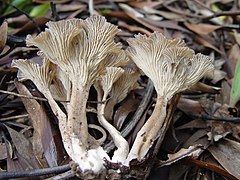Faerberia
| Faerberia | |
|---|---|

| |
| Scientific classification | |
| Kingdom: | |
| Division: | |
| Class: | |
| Order: | |
| Family: | |
| Genus: | Faerberia Pouzar (1981)
|
| Type species | |
| Faerberia carbonaria | |
| Synonyms[1] | |
| |
| Faerberia | |
|---|---|
| Gills on hymenium | |
| Cap is umbilicate | |
| Hymenium is decurrent | |
| Stipe is bare | |
| Spore print is white | |
| Ecology is saprotrophic | |
| Edibility is edible | |
Faerberia is a fungal genus in the family Polyporaceae. It is a monotypic genus, containing the single species Faerberia carbonaria, which is commonly known as the firesite funnel due to its habitat of burned soil.[2][3]
Taxonomy
[edit]This species was originally described in 1805 as Merulius carbonarius by botanists Johannes Baptista von Albertini and Lewis David de Schweinitz.[1] Faerberia was circumscribed in 1981 by Czech mycologist Zdeněk Pouzar.[4]
Description
[edit]Faerberia carbonaria is a small funnel mushroom with tough grey-white flesh. Although it belongs to the family Polyporaceae it does have gills. As a somewhat rare, monotypic, gilled polypore with a habitat of burned soil it is therefore quite an unusual species.
Cap: 0.5–2 cm. Funnel shaped and umbilicate, smooth or lightly fibrous texture. The cap margin is usually scalloped and inrolled. Stem: 1.5–7 cm. Often curved, irregular and fused together above the swollen base which sometimes displays white rhizoids. Gills: Grey, becoming paler towards the stipe. Thick, decurrent and usually with significant forking. Spore print: White. Spores: Ellipsoid, smooth, non-amyloid. 8–9.5 x 4.5–5.5 μm. Taste: Indefinite and mild. Smell: Faint and indefinite.[5]
Habitat and distribution
[edit]F. carbonaria grows on burned soil with woodland fire sites being its most common habitat. It may grow in small trooping groups or be found individually but it is an uncommon find appearing through summer and autumn.[citation needed]
Edibility
[edit]Whilst it is an edible mushroom, it is regarded as a poor choice due to its tough texture, mild taste and general rarity.[6]
References
[edit]- ^ a b "Species Synonymy: Faerberia carbonaria (Alb. & Schwein.) Pouzar [as 'carboniaria']". Species Fungorum. CAB International. Retrieved 2014-01-23.
- ^ Hrouda, Petr (2001-06-10). "Pleurotoid fungi of the family Polyporaceae in the Czech Republic and Slovakia". Czech Mycology. 53 (1): 29–87. doi:10.33585/cmy.53102.
- ^ Phillips, Roger (2014-02-18). "Rogers Mushrooms - Faerberia carbonaria Mushroom - Archive of original page". RogersMushrooms. Archived from the original on 2014-02-18. Retrieved 2022-07-07.
- ^ Pouzar Z. (1981). "Faerberia, a genus of cantharelloid fungi". Ceská Mykologie. 35 (3): 185–5.
- ^ Buczacki, Stefan (2012). Collins fungi guide. London: Collins. ISBN 978-0-00-724290-0. OCLC 793683235.
- ^ "Shroomers - Firesite funnel - Faerberia carbonaria". www.shroomers.app. Retrieved 2022-07-07.
